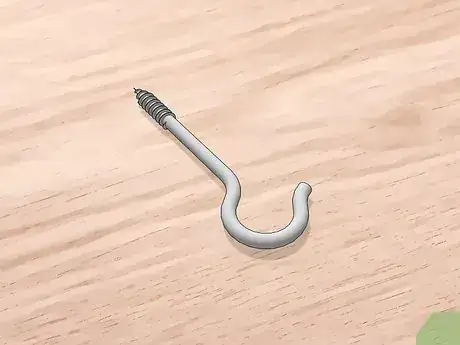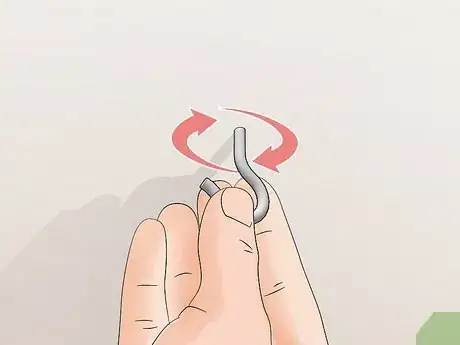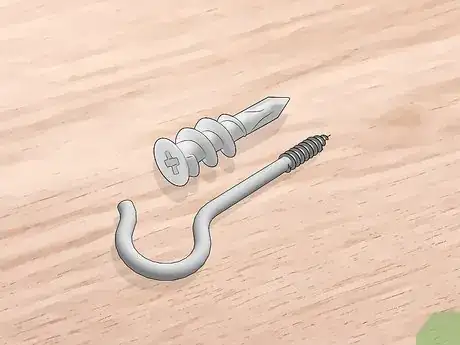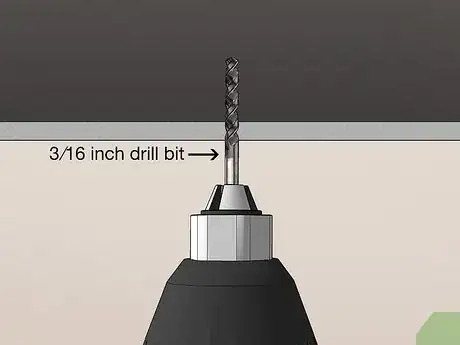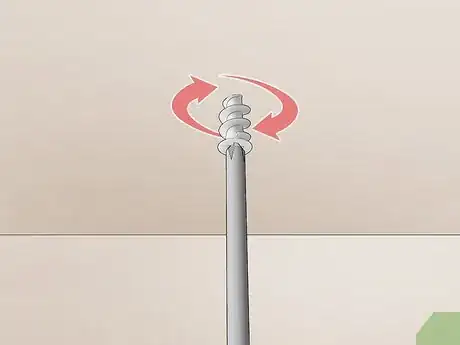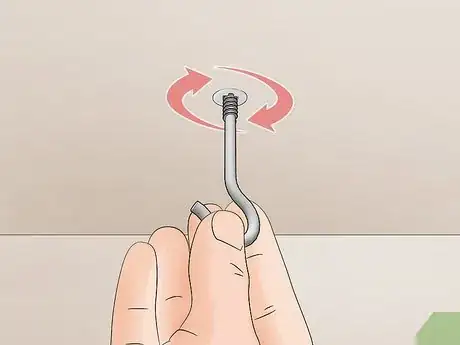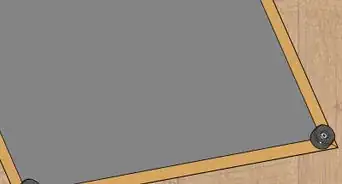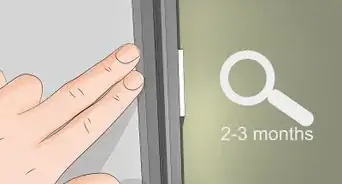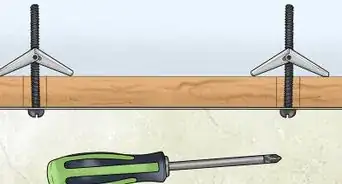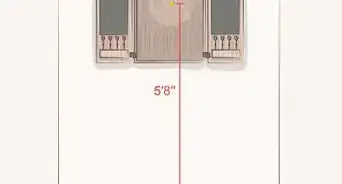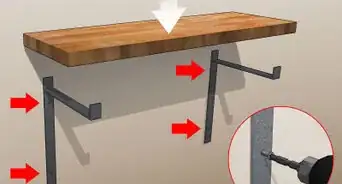This article was co-authored by wikiHow Staff. Our trained team of editors and researchers validate articles for accuracy and comprehensiveness. wikiHow's Content Management Team carefully monitors the work from our editorial staff to ensure that each article is backed by trusted research and meets our high quality standards.
There are 8 references cited in this article, which can be found at the bottom of the page.
This article has been viewed 39,025 times.
Learn more...
Mobiles are fun and oftentimes beautiful decorations that spin in the air. They can be used as art, but they are also toys commonly placed above a baby’s crib. Mobiles are often suspended from the ceiling. The hanging process can vary a little depending on where you intend on hanging the mobile. Use the mobile's size and weight to choose a good spot where it can hang at the proper height and rotate freely. Then, screw a hook directly into a support beam in the ceiling for maximum stability. If you’re planning on hanging a mobile on bare drywall or plaster, get an anchor or toggle bolt. Secure the mobile in place, then watch it spin and even soothe young children.
Steps
Attaching a Mobile to a Ceiling Joist
-
1Select a 1⁄4 in (0.64 cm) screw hook to install on the ceiling. Screw hooks, or cup hooks, come in a variety of sizes. A screw hook has a threaded end that fits in the ceiling like a screw and a hook end you can use to hold the mobile. Small ones are more than capable of handling most mobiles. The size isn’t too important, but it determines what kind of drill bit you need later.[1]
- Screw hooks are available online and at most hardware stores. The other tools you need for the installation are also available at these places.
-
2Use a stud finder to locate the support beams in the ceiling. Your ceiling has wood beams called joists, which are very useful for supporting the weight of anything you hang up. A stud finder is a handheld electronic device that detects joists through drywall and other material. Move the stud finder over the ceiling and wait for it to light up and beep. Mark the positioning of any studs near the area where you plan on hanging the mobile.[2]
- The joists are typically spaced 16 to 24 in (41 to 61 cm) apart. Once you find one, you can measure out to estimate where the next one will be.
- You may wish to hang the mobile in a spot that doesn’t have joists. That is okay, but it requires a few extra steps. Use a drywall anchor or toggle bolt to secure it.
Advertisement -
3Mark the spot where you plan on hanging the mobile. Measure out from the wall space as needed, making sure you’re following the joists. Plan on securing the mobile directly to the center of a joist. Note the spot with a pencil.[3]
- To make the mark visible, you can also make a dent in the spot you marked. Position a nail there and lightly tap it with a hammer.
-
4Drill a pilot hole through the ceiling with a 3⁄16 in (0.48 cm) drill bit. Position a stepladder underneath the spot you plan on hanging the mobile from. Insert the drill bit into a power drill, then drill through the mark you made. Try drilling about 2 in (5.1 cm) deep into the joist to create room for the hanger.[4]
- Keep in mind that the size and depth of the pilot hole depend on the hanger you’re planning on using. Make the hole roughly the same size as the screw hook.
-
5Place the screw hook and turn it clockwise to tighten it. Slide the threaded end of the screw hook into the pilot hole. Then, keep a firm grip on it as you begin twisting it by hand. Twist it until the threaded end passes all the way through the ceiling, leaving only the hook end visible.[5]
- The hook will become harder to turn as it penetrates deeper into the joist. If it becomes too difficult to rotate by hand, try using pliers.
- Stop twisting the hook once the base is flush with the ceiling. Overtightening it could damage the hook’s threads or the ceiling.
-
6Place the mobile on the hook to hang it. Pick up the completed mobile, climb up, and drape it on the hook. Most mobiles have a length of string or a hook that fits perfectly over the one you have in the ceiling. Make sure the mobile is secure on the hook afterward.[6]
- If you need a way to attach the mobile to the hook, tie a length of string to it. You could also tie a hook or ring to the string and fit it on the end of the screw hook.
Using Drywall Anchors and Toggle Bolts
-
1Select a 3⁄16 in (0.48 cm) drywall anchor if a stud isn’t available. Drywall anchors are basically plastic plugs that function as hangers in plain drywall. Select an anchor that is roughly the same size as the screw hook you plan to use. There are many different types of anchors, so check out the weight ratings when choosing one. Make sure the anchor you choose is able to support the weight of the mobile.[7]
- Mobiles are often pretty light, so plastic drywall anchors are generally all you need. Many of them support up to 30 lb (14 kg) of weight.
- Note that drywall anchors only work for drywall, so you should choose a toggle bolt if you’re working with a plaster ceiling.
-
2Pick a 3⁄16 in (0.48 cm) toggle bolt if you have a plaster ceiling. Toggle bolts are very similar to drywall anchors and come in metal and plastic varieties. The plastic kind is a better option for hanging mobiles. Toggle bolts tend to be a little stronger and carry more weight than drywall anchors. They work on both plaster and drywall.[8]
- The plastic toggle bolts have a spot for you to install a hook to hang the mobile. The metal ones don’t have this spot, so they are more useful for securing things like mounting brackets.
-
3Use a pencil to mark the spot where you want to hang the mobile. Select somewhere with plenty of space for the mobile. You may wish to measure out from the wall to ensure the mobile has enough room to rotate freely. Then, make a small mark so you know where to drill during the installation. [9]
- If you need to, determine the mobile’s width first so you know how much room it needs to rotate.
-
4Drill a 3⁄16 in (0.48 cm) pilot hole through the ceiling. After determining where you will hang the mobile, set up a stepladder nearby. Make the hole as deep as the anchor you plan on using. Most of the time, a 2 in (5.1 cm) hole will be deep enough, but adjust it as needed to fit the anchor.
- Keep the pilot hole roughly the same size as the anchor you plan on installing.
-
5Push the anchor all the way into the pilot hole. Slide the threaded end of the anchor into the ceiling. If it’s stuck, try rotating it clockwise to push it deeper into the ceiling. Position it so the opposite end is flush with the ceiling. If you’re using a drywall anchor, you can also hammer it lightly to secure it in place.[10]
- Toggle bolts have a plastic strap on the end. Pull it toward you, then look for a ring in the center to push toward the bolt at the same time. Finally, snap the plastic off to secure the bolt.
-
6Twist a screw hook into the anchor’s opening. The anchor will have room for a screw hook roughly the same size. Insert the threaded end of the screw hook into the anchor. Then, turn it clockwise by hand to tighten it. Continue turning it until the base of the hook is flush with the anchor.[11]
- Avoid overtightening the hook, since that could damage the threads or the anchor. Overtightened hangers are difficult to remove if you need to take them back out.
-
7Set the mobile on the hook to finish hanging it. Pick up the completed mobile by one end. Check for a string or a hook. Most mobiles have something you can set on top of the screw hook. Make sure both the screw hook and the mobile are secure.[12]
Warnings
- Mobiles can be dangerous if they aren’t positioned correctly. Keep them out of the reach of small children and make sure they are well-secured so they don’t fall from the ceiling.⧼thumbs_response⧽
Things You’ll Need
Selecting a Hanging Spot
- Assembled mobile
- Tape measure
- Scale (optional)
Attaching a Mobile to a Ceiling Joist
- Stud finder
- Pencil
- 1⁄4 in (0.64 cm) screw hook
- Drill
- 1⁄4 in (0.64 cm) drill bit
Using Drywall Anchors and Toggle Bolts
- 3⁄16 in (0.48 cm) drywall anchor
- 1⁄4 in (0.64 cm) screw hook
- Drill
- 1⁄4 in (0.64 cm) drill bit
References
- ↑ https://thriftandspice.com/diy-circle-chandelier/
- ↑ https://www.youtube.com/watch?v=ZIwOZa7aiOQ&feature=youtu.be&t=34
- ↑ https://thriftandspice.com/diy-circle-chandelier/
- ↑ https://www.youtube.com/watch?v=ZIwOZa7aiOQ&feature=youtu.be&t=46
- ↑ https://astepinthejourney.com/2013/10/how-to-make-a-mobile-baby-using-paint-chips.html
- ↑ https://www.youtube.com/watch?v=rZbtLMI3CqA&feature=youtu.be&t=623
- ↑ https://www.youtube.com/watch?v=LWhkrXtpgXw&feature=youtu.be&t=161
- ↑ https://www.thisoldhouse.com/how-to/how-to-choose-right-hanging-hardware
- ↑ https://thriftandspice.com/diy-circle-chandelier/
